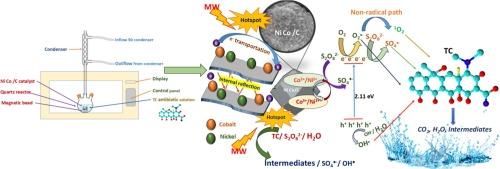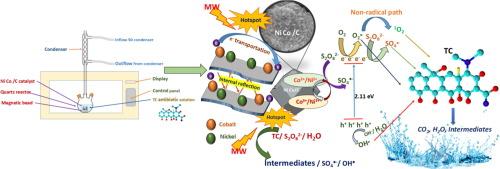镍修饰的ZIF-67 (Co) MOF衍生双金属催化剂在过硫酸盐活化下微波辐射高效降解四环素:性能评估和预测中间毒性谱
IF 9
1区 工程技术
Q1 ENGINEERING, CHEMICAL
引用次数: 0
摘要
在本研究中,完成了四环素(TC)去除性能的评估,并预测了生成的中间体的生态毒理学效应。通过对镍修饰的十二面体ZIF-67模板进行热解,成功合成了镍修饰的多面体ZIF-67 (Co) MOF衍生双金属催化剂。因此,在以下基于微波(MW)的操作条件下:催化剂剂量0.6 g/L, TC初始浓度为10 mg/L, MW输入功率450 W, pH不变,Ni修饰的ZIF-67 (Co)衍生催化剂Ni Co/C在MW暴露2 min内显示出97.59 %的TC去除率。磁性(即Ni和Co)和介电(即碳)对应物增强了更好的微波吸收,同时减少了反射损耗。吸收的微波能量被耗散形成局部的“热点”,用于PS、H2O和TC分子的直接分解,而掺杂Ni的导电碳基体则传播电子迁移率,产生游离自由基。纳米碳笼封装的氧化还原对(即Co2+/Co3+和Ni2+/Ni3+)的电子-空穴对分离和电子转移的MW诱导“光电”效应导致各种活性自由基的产生,包括硫酸盐(SO4•−)、羟基(●OH)、超氧阴离子(●O2 -)自由基和单线态氧(1O2), EPR证实了这一点。ECOSAR和T.E.S.T.软件分析了中间体的理论生态毒理学效应,这可能突出了未来对高级氧化工艺处理废水排放的严格规定和对缓解过程的进一步研究的必要性。此外,对天然水中TC降解的可重用性研究和评估表明,Ni修饰的ZIF-67 (Co)衍生催化剂Ni Co /C具有成为下一代mw响应催化剂的能力,可以处理各种新出现的污染物。本文章由计算机程序翻译,如有差异,请以英文原文为准。


Nickel-decorated ZIF-67 (Co) MOF derived bi-metallic catalyst for efficient degradation of tetracycline under microwave irradiation through persulfate activation route: Performance assessment and predictive intermediate toxicity profile
In this study, tetracycline (TC) removal performance evaluation was accomplished alongside the prediction of the eco-toxicological effect of the generated intermediates. The polyhedron shaped nickel (Ni)-decorated ZIF-67 (Co) MOF derived bi-metallic catalyst was synthesized successfully by pyrolysis of the Ni-modified rhombic dodecahedron shaped ZIF-67 template. Therefore, under the following microwave (MW) based operation conditions: catalyst dose 0.6 g/L, initial concentration of TC 10 mg/L, MW input power 450 W, and at unchanged pH, Ni-decorated ZIF-67 (Co) derived catalyst Ni Co /C displayed ∼97.59 % TC removal within only 2 min of MW exposure. Magnetic (i.e., Ni and Co) and dielectric (i.e., carbon) counterparts enhanced better microwave absorption while reducing reflective loss. The absorbed microwave energy was dissipated to form localized ‘hotspots’ for direct decomposition of PS, H2O, and TC molecules whereas conductive carbon matrix with Ni doping propagated electronic mobility for free reactive radical generation. The MW induced ‘photo-electric’ effect of electron-hole pair separation and electron transfer via redox couples (i.e., Co2+/Co3+ and Ni2+/Ni3+) encapsulated in carbon nanocage resulted in the generation of various reactive free radicals including sulfate (SO4•−), hydroxyl (●OH), superoxide anion (●O2–) radicals and singlet oxygen (1O2) which were confirmed by EPR. The theoretical eco-toxicological effects of intermediates were analyzed by ECOSAR and T.E.S.T. software, which may highlight the need for stringent rules in the future regarding the discharge of advanced oxidation process-treated wastewater and further research on the mitigation process. Moreover, the reusability study and evaluation of TC degradation in natural water showcased the calibre of this Ni-decorated ZIF-67 (Co) derived catalyst Ni Co /C to become a next-generation MW-responsive catalyst to tackle various emerging contaminants.
求助全文
通过发布文献求助,成功后即可免费获取论文全文。
去求助
来源期刊

Separation and Purification Technology
工程技术-工程:化工
CiteScore
14.00
自引率
12.80%
发文量
2347
审稿时长
43 days
期刊介绍:
Separation and Purification Technology is a premier journal committed to sharing innovative methods for separation and purification in chemical and environmental engineering, encompassing both homogeneous solutions and heterogeneous mixtures. Our scope includes the separation and/or purification of liquids, vapors, and gases, as well as carbon capture and separation techniques. However, it's important to note that methods solely intended for analytical purposes are not within the scope of the journal. Additionally, disciplines such as soil science, polymer science, and metallurgy fall outside the purview of Separation and Purification Technology. Join us in advancing the field of separation and purification methods for sustainable solutions in chemical and environmental engineering.
 求助内容:
求助内容: 应助结果提醒方式:
应助结果提醒方式:


